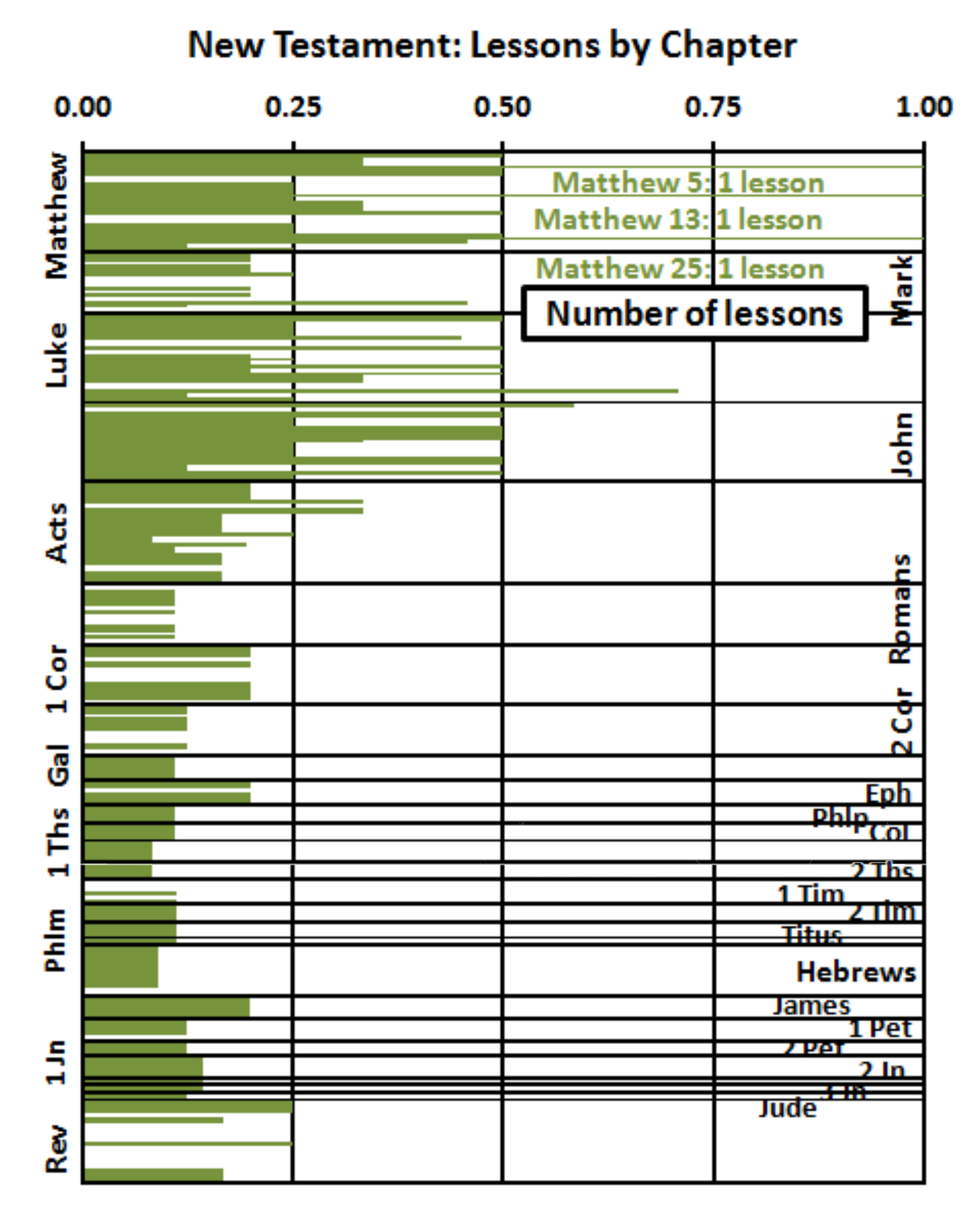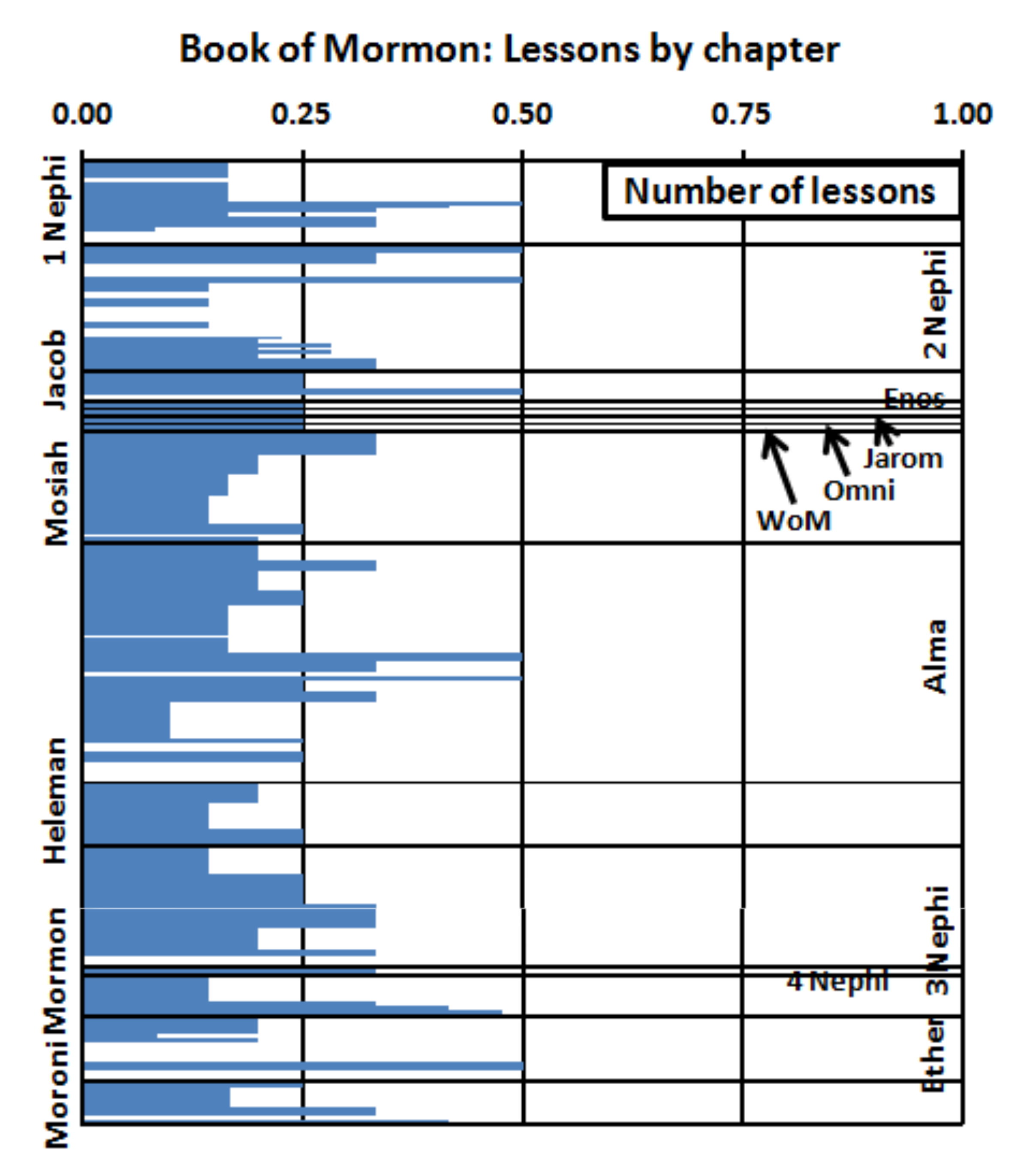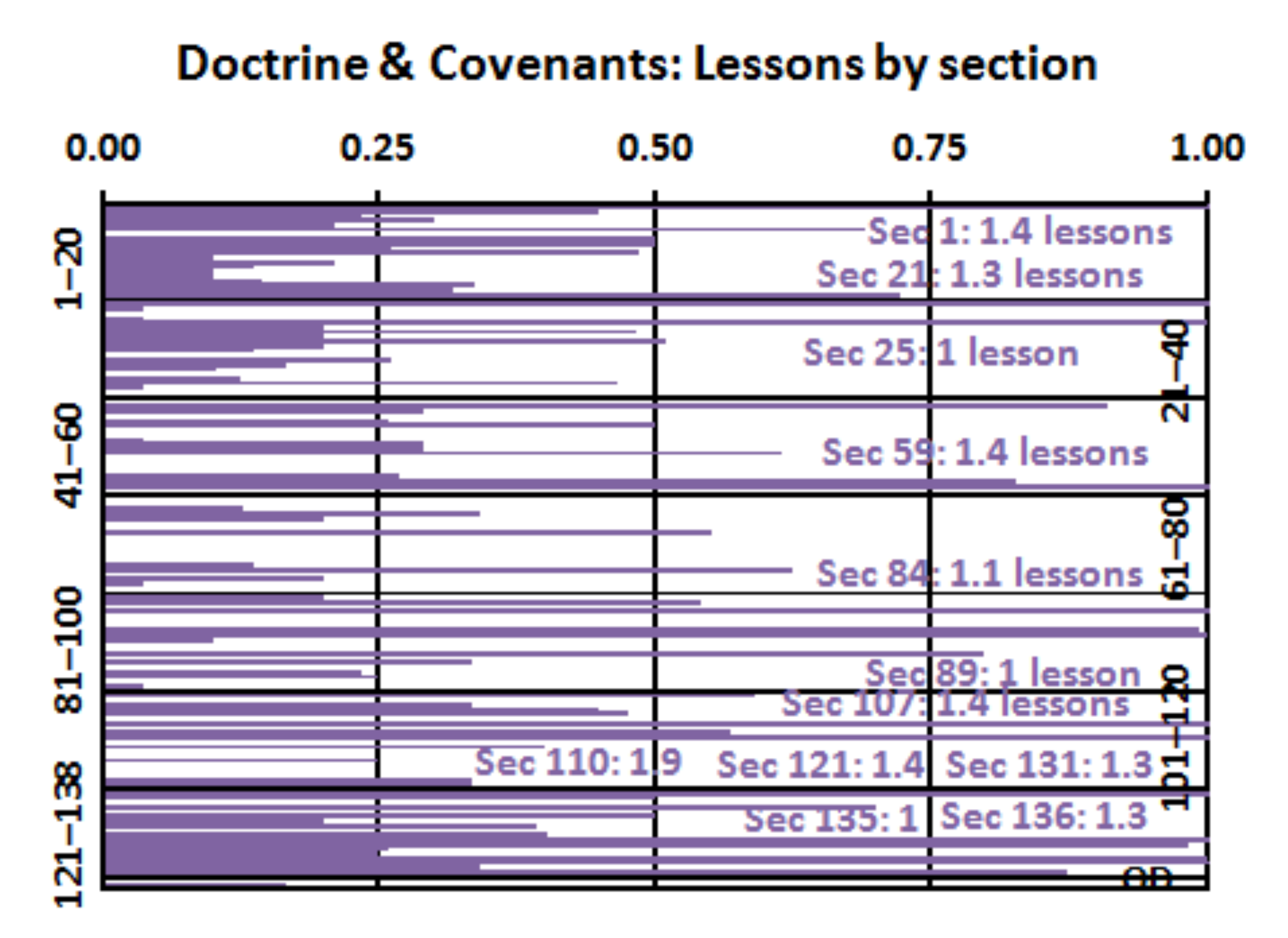We just finished talking about the war chapters at the end of Alma a couple of weeks ago, in my ward’s Sunday School anyway. Discussion of these chapters sometimes brings up an argument about whether all scriptures are equally valuable, since of course if you don’t believe they are, these chapters are perfect examples to cite.
I got to thinking that it might be fun to try to answer this question empirically. To do so, I looked at how much time the Sunday School manuals spend on each chapter of the scriptures. This can tell us how doctrinally important each chapter is. Of course it’s a pretty crude measure and it’s just one class in church, but at least it’s a starting point.
I looked at the most recent Sunday School manuals for the Old Testament, New Testament, Book of Mormon, and Doctrine and Covenants/Church history. For each lesson, I looked at the scriptures listed at the very beginning of the lesson under the heading “Preparation.” I checked which chapters in the scriptures were referred to. I then assigned each chapter an equal fraction of the lesson. This sounds more complicated than it is. Here’s an example: Book of Mormon lesson 2 refers to 1 Nephi 1 – 5 and 7. This is a total of 6 chapters, so I credited 1/6 lesson to each of the 6 chapters.
This analysis was chapter level, not verse level, so I counted any reference to a chapter equally, even if it was only to a single verse in the chapter. (In practice, this probably didn’t make much difference, as most references were to whole chapters, or at least large parts of them.) I ignored any references that were listed as “additional” or “supplemental.” I also ignored any references to non-scriptural readings; I divided credit only among scriptures referred to. For example, D&C lesson 4 refers to Joseph Smith History and D&C 3, 5, 10, 17, 20, and 84; a total of 7 chapters in scripture. It also refers to some pages in Our Heritage. I didn’t count the Our Heritage part, though, so I credited each of the scriptural chapters with 1/7 lesson. Finally, there were a few lessons in the D&C manual that didn’t list any scriptures in the “Preparation” section. For these lessons, I just looked through the entire main part of the lesson and counted all the D&C sections that were referred to at least once.
Here’s the result for the Old Testament.
 This is pretty slim coverage, particularly after Genesis. Whole books are skipped! I guess that’s what we get for trying to cover such a large book in just one year of lessons. The only chapter that gets as much as one lesson is Daniel 2, the one where Daniel interprets Nebuchadnezzar’s dream of the stone cut out of the mountain without hands.
This is pretty slim coverage, particularly after Genesis. Whole books are skipped! I guess that’s what we get for trying to cover such a large book in just one year of lessons. The only chapter that gets as much as one lesson is Daniel 2, the one where Daniel interprets Nebuchadnezzar’s dream of the stone cut out of the mountain without hands.
Here’s the result for the New Testament.
 It looks like Matthew is our favorite gospel, while Mark gets largely ignored. Among the epistles, it looks like we avoid paying too much attention to Romans, probably because it has all that malarkey about grace! 🙂
It looks like Matthew is our favorite gospel, while Mark gets largely ignored. Among the epistles, it looks like we avoid paying too much attention to Romans, probably because it has all that malarkey about grace! 🙂
The chapters that get one lesson’s worth of attention are Matthew 5 (Sermon on the Mount, Beatitudes), Matthew 13 (parables including the sower, the wheat and tares, and the mustard seed), and Matthew 25 (parables including the ten virgins, the talents, and the sheep and the goats).
Here’s the result for the Book of Mormon. It looks like the gaps here are in 2 Nephi (Isaiah quotes), the war chapters in Alma, and the war chapters in Ether. No chapter gets as much as one lesson’s worth of attention.
It looks like the gaps here are in 2 Nephi (Isaiah quotes), the war chapters in Alma, and the war chapters in Ether. No chapter gets as much as one lesson’s worth of attention.
Here’s the result for the Doctrine and Covenants. What’s interesting here, I think, is the variability. There are many sections that we skip over entirely, and many others that we talk about a lot. I guess this shouldn’t be surprising, considering how many D&C sections are about mundane details of church administration.
What’s interesting here, I think, is the variability. There are many sections that we skip over entirely, and many others that we talk about a lot. I guess this shouldn’t be surprising, considering how many D&C sections are about mundane details of church administration.
The sections getting one or more lesson’s worth of attention are 1 (the only true and living church), 21 (give heed to all of Joseph Smith’s words), 25 (Emma and the hymns), 59 (Sabbath, confess God’s hand), 84 (oath and covenant of the priesthood), 89 (Word of Wisdom), 107 (priesthood offices), 110 (vision of Jesus and others in the Kirtland Temple), 121 (no power or influence can or ought to be maintained by virtue of the priesthood), 131 (new and everlasting covenant of marriage), 135 (Joseph and Hyrum killed), and 136 (organizing the move west).
Here’s the result for the Pearl of Great Price.
Of course the Pearl of Great Price doesn’t have its own manual. The references come from the Old Testament and D&C manuals. The chapters getting one or more lesson’s worth of attention are Moses 1 (Moses meets God; God’s work and glory), Joseph Smith History (First Vision, vision of Angel Moroni, obtaining the Book of Mormon), and the Articles of Faith (our non-creedal creed).
This probably sounds like a minor thing, but what really sticks out to me in these charts is how different the lengths of the books of scripture are that we try to cover in a year. The Old Testament in particular is so much longer than the others that it’s no surprise that we skip or skim so much of it. And the D&C is so short, and has so much skip-worthy material, it’s also not surprising that we get to talk about quite a few sections in one or more lessons.

This is fascinating! To me, it’s a good case for not basing our curriculum on one book/year: we obviously give a lot more love to the shorter books. There is so much good stuff in the OT (or stuff certainly worthy of discussion, like what on earth were the writers thinking).
I was surprised at the statement that reading what the teacher books that were written in 1995; and which are about various issues rather than about the scriptures, can tell us which religious books are most important to us.
Every year we talk about the same issues. The thing that makes the difference for me is what the teacher does with what she is given.
Before 1995 the teaching manuals changed every year. The few changes that have been made over the last nearly 20 years has been to update current information.
I found the work you did to be most interesting. Thank you for that.
This is fascinating, Ziff! Thanks for putting it together.
On my mission my companions and I (yup, each companionship) decided that we would read the scriptures together for companionship study. Over the course of the mission, I ended up reading the KJV cover-to-cover four times. Several of my comps mentioned that they had never read the Old Testament before, and I think that your graph explains part of why: for some reason we just don’t pay much attention to it.
As interesting as the actual result is that you found a way, however approximate it might be, to measure this and make it visible. Bravo!
I am agog.
Agog.
It always makes me sad that all we give the Psalms is a single hour of discussion once every four years. We are seriously missing out–on the Psalms and on much else.
This is fascinating Ziff! On a somewhat related note, I have always been fascinated by parts that seem to be intentionally left out of the SS manuals. For example, when the manual tells you to read specific parts of a chapter, but leaves out the part of the chapter that would be potentially controversial. For example, last year our SS teacher brought up the scriptures in Paul that talk about the woman obeying her husband and the husband loving his wife as Christ loves the church. I wasn’t too happy with the way this was covered by the SS teacher even though I had really enjoyed his lessons in the past. When I went back and looked at the SS manual, those scriptures were not included in the original reading assignment or even in the “supplemental’ section. I really wonder why he felt the need to cover them.
Anyway…I think it would be fascinating to compile a list of the specific parts of chapters that seem to be intentionally avoided.
Fascinating! I’d be curious to know if you get the same sort of spread as measured by General Conference citations (based on this dataset: http://scriptures.byu.edu/ ).
Nice work Ziff. Interesting to see this laid out quantitatively.
And Eve, ditto on the Psalms! Vastly underread and appreciated. http://timesandseasons.org/index.php/2012/09/nyc-institute-announcement-psalms-and-israelite-poetry/
Fascinating.
When I first started teaching GD, the curriculum spent two years on each book rather than one, for an eight-year cycle. My understanding is that they switched to our current four-year cycle becauset they didn’t want people to go that long before studying the BoM again. I really liked the two-year schedule, as it allowed much more time to let the readings really breathe. But I do acknowledge that people can get tired of spending that much time on a single volume of scripture, and the one-year schedule may keep their attention fresher.
Pet peeves:
1. When I’m teaching GD, I always hated the prominent admonitions to read the BoM every day. That was great during BoM years, but not so much during the other years, because that meant most people weren’t preparing at all for GD class, because most people aren’t going to read *both* BoM and OT or whatever. (But then most people don’t read the assigned scriptures anyway, so maybe it doesn’t matter.)
2. We never, ever, actually study the beginning of the OT; the default is to cover that material with the PoGP parallel chapters. I hate that; if we’re going to study OT, let’s study OT, and if we want to study PoGP, let’s do that.
3. I hate that when they want to skip over a whole bunch of material they put it on the reading schedule anyway. Such as this year, when they had us read all of the Isaiah material for a single class. That’s their way of saying in effect, Hey, we know you hate this stuff so just skim and we’ll see you on the other side next week. But as a teacher I feel an obligation to prepare the entire assignment. Those weeks just kill me.
I had a friend, a professional writer, who in her late 60s was asked to rewrite some Baptist lesson manuals. She thought of herself as someone who had read the Bible through many times.
It was the first time she encountered the story of Zipporah — when she was going through and ghost writing for them.
Interesting what we find and what we miss if we do not actually read through cover to cover.